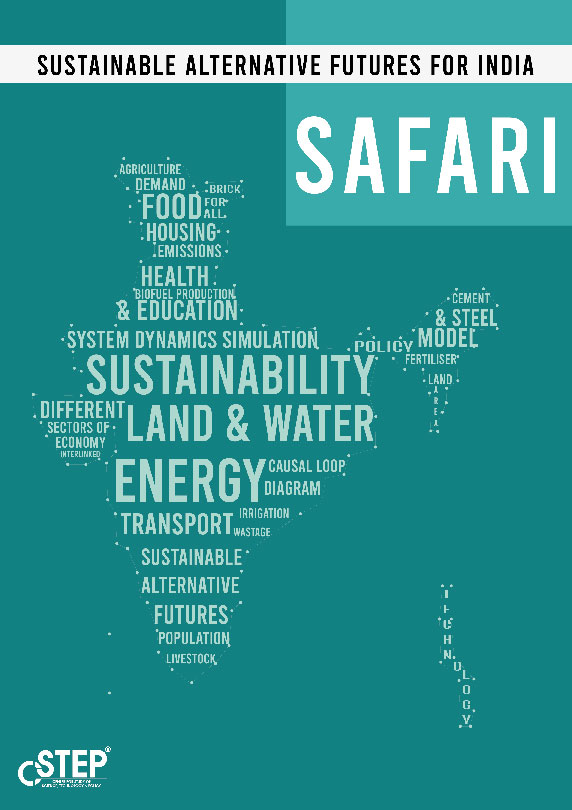Climate change mitigation involves strategies aimed at decreasing greenhouse gas emissions, promoting renewable energy sources, improving energy efficiency, and implementing sustainable practices. CSTEP focuses on building models to simulate India's future across sectors, such as transport, industries, buildings, agriculture, and forestry, to find interventions required to achieve a sustainable and secure future. Our work also involves the study of certain themes that cut across sectors (quality of life and development vs climate action, water and land demands for agriculture vs power, etc).
CSTEP's SAFARI model: Balancing development with climate action requires a good understanding of the interactions between sectors, natural resource systems, and environmental externalities. The Climate Change Mitigation at CSTEP has undertaken a modelling study with the aim to provide such an understanding and help create scenarios for low-carbon development through the use of an interactive simulation tool called Sustainable Alternative Futures for India (SAFARI). You can access the tool here.
SAFARI estimates the energy, emissions, and resources implications of achieving developmental goals such as food, housing, healthcare, education, power for all, and transport up to 2050. The user interface allows you to explore these implications as well as the trade-offs between them. Using SAFARI, you can create integrated scenarios across sectors and test out the impact of policy choices on energy, emissions, and resources. Ultimately, we hope that this tool can be used to provide insights into developing and tracking India's long-term strategy (LTS) in line with the Paris Agreement. For more information, please contact safari@cstep.in



Forests: An essential piece in the decarbonisation puzzle
Over the past two decades, India has seen growth in forest and tree cover despite developmental activities. India in its 2015 Nationally Determined Contributions (NDC) committed to creating an additional sink of 2.5 to 3 billion tonnes of carbon dioxide equivalent (CO2-e) through the expansion of forest and tree cover by 2030.
Low-Carbon Transition of Petrochemical Industries in India
The growth of the Indian petrochemical industry can be made sustainable only by mitigating the emissions from it. This study examines the decarbonisation potential of India’s petrochemical sector until 2050 through low- or zero-emission technologies. It also underlines measures for decarbonising this hard-to-abate sector, with the aim to provide inputs for devising suitable strategies and guide policy formulation.
India’s Building Code Has a Blind Spot for a Whole Category of Emissions
Building codes are not new to India, and the first iteration of the National Building Code (NBC) dates back to 1970. While the NBC had general building guidelines in place, there were none pertaining to regulating emissions from the building sector. In 2002, the Bureau of Energy Efficiency (BEE) was established under the Energy Conservation Act to spearhead energy and emission-related regulations.
PRESS RELEASE: Bengaluru has the potential to reduce PM10 emissions by 21% by 2024, says CSTEP study
The studies, “Emission Inventory and Pollution Reduction Strategies for Bengaluru” and “Identification of Polluting Sources for Bengaluru: Source Apportionment Study”, point to transportation and road dust as the biggest contributors to air pollution in Bengaluru city. These studies were conducted under the aegis of KSPCB and supported by The Bloomberg Philanthropies and Shakti Foundation, to generate scientific data and contribute to India’s National Clean Air Programme (NCAP).
PRESS RELEASE - CSTEP Study: Prepare for Warmer Temperature and High-Intensity Rainfall Events in Eastern India
A study by the Center for Study of Science, Technology and Policy (CSTEP)—a Bangalore-based think tank—on the climate of eastern India underscores the need for climate risk mapping and climate action. The study ‘District-Level Changes in Climate: Historical Climate and Climate Change Projections for the Eastern States of India’ projects changes in temperature and rainfall patterns in Bihar, Jharkhand, Odisha, and West Bengal—the eastern states of India—over the next three decades compared to the historical period (1990–2019).
PRESS RELEASE: New report asks important questions as India develops net-zero strategy
As we inch closer to another global climate summit, COP27, climate projection models will once again be thrust into the limelight as they play an important role in devising net-zero strategies. However, assumptions and estimates for India’s ‘net zero by 2070’ target need to be reviewed carefully given the deep uncertainties involved. There is no correct pathway to net-zero emissions.
Sustainable Tomorrow: Ways to bridge the gaps in addressing India’s climate commitments
With India’s ambitious 2030 clean energy targets and the 2070 net-zero goal, more was expected from the Union Budget 2023-24 to increase the uptake of electric vehicles (EVs) and solar photovoltaics (PVs). Currently, the EV market is struggling because of low penetration rates, and solar PVs have high production costs. Integrating EVs and solar PV systems could be a viable option for electric mobility in India, but without concessional financing available, the cost of solar projects would be too high, resulting in increased EV charging costs for consumers.
Biodiversity and Food Security: Two pieces of the same puzzle
India is highly dependent on the agriculture sector for its food security, and biodiversity loss leaves crops vulnerable to pests and diseases, thereby lowering yields. It also leads to the increased occurrence of invasive species and reduces the pollinator population. Thus, the interlinkage between food security and biodiversity loss needs to be understood in its entirety.